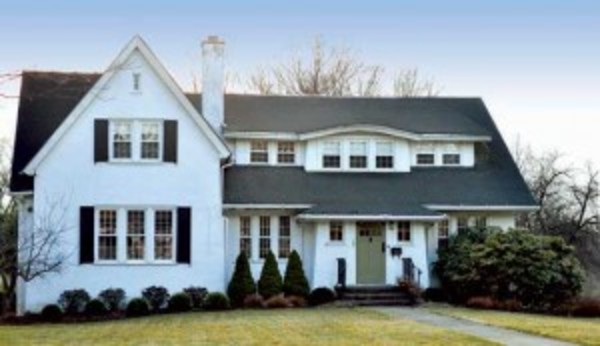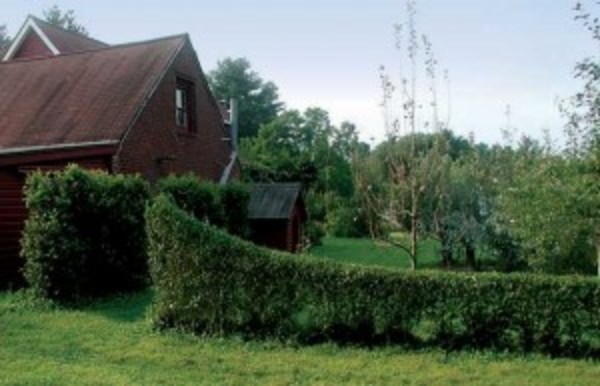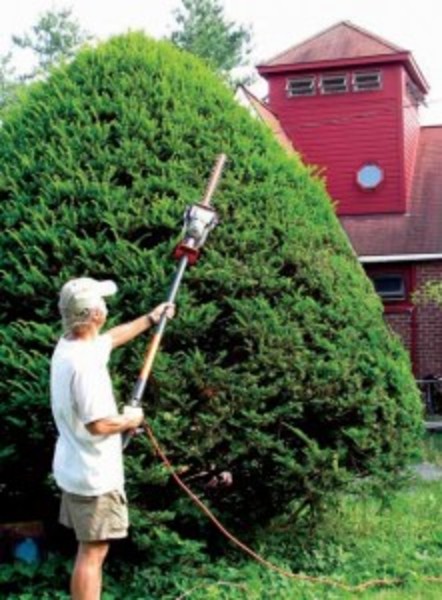
Evergreens in various shapes, textures, and sizes offer a balance of harmony and contrast around this eclectic early 20th-century house.
Adding shrubs around an old house can be a great way to create a period landscape and make a house look its best.
One popular traditional use of shrubs is as foundation plantings. While the ostensible purpose of foundation plantings is to hide the foundation, the stone foundations of many period homes hardly need to be covered up. Instead, when shrubs are planted beside a house, they soften the contrast between the vertical surface of the exterior wall and the horizontal surface of the adjacent ground—a contrast most dramatic at the corners, where taller shrubs or trees are needed to further ease the transition. A well-executed foundation planting also lends a visual rhythm to a home’s exterior.
Beyond the reach of a home’s walls, shrubs help create the vistas so beloved by homeowners a hundred years ago. As Frank J. Scott, a prominent designer of Victorian-era landscapes, wrote in his 1886 opus Art of Beautifying Suburban Home Grounds, “Preserve in one or more places (according to the size and form of the lot) the greatest length of unbroken lawn that the space will admit.” Shrubs were used to help define these unobstructed sight lines from selected vantage points, such as terraces or picture windows. A well-placed stand-alone shrub or cluster of shrubs could likewise draw the eyes out into such a vista, as well as block some distractions—a neighbor’s garden shed, for instance—so the scene beyond the property line could be effectively “borrowed” and incorporated into a now expanded view.

Fast-growing privet can be trimmed to a variety of whimsical forms, like this garden entryway.
Horticultural exuberance, fueled by new plant introductions from foreign lands, was an earmark of landscapes at the turn of the 20th century, and it extended to shrubs, which were often sheared into fancifully shaped topiaries. Topiaries are well-suited to today’s gardens, period or otherwise, and can imbue the landscape with elegance or whimsy. Today’s modern tools—like battery-powered and pole-mounted hedge shears—make maintaining such fancy forms easier than ever.
Lastly, shrubs planted in rows as either formal or informal hedges are a timeless garden element. Besides providing barriers to sound and sight, such green walls can create passageways and cordon off areas within a garden to create “rooms” or “hallways.”
While a wall of shrubs needs regular maintenance, it is less expensive to create than a built wall, and its appearance can change not only throughout the year, but even from year to year, depending upon your shaping whims. As with topiary, hedge maintenance today is made easier with modern tools.

A well-pruned lilac shrub offers fragrance and color.
Plant for Success
Whether you’re planting a single old-fashioned quince bush or a 50′-long hedge of forsythia, success will depend on matching the plant to the site. The three most important considerations are climate, soil drainage, and sunlight.
Consider winter temperatures. The U.S. and Canada have been divided up into 11 USDA Hardiness Zones according to each region’s average minimum cold temperatures, with the lower numbers representing colder climates. Find out the growth zones of your desired shrubs, and don’t select any that can’t handle your zone’s lowest temperatures. Other climate considerations also factor in, but winter cold is the most important.
Soil drainage also is critical because air, which roots need to function, is displaced by water in overly wet soil. Water that stands for too long on the soil after a rain (or in a hole that you’ve filled with the hose) indicates poor drainage, as does the presence of plants such as cattails, purple loosestrife, or buttercups. Where drainage is poor, you can install drainage ditches or bury perforated pipes to carry water away to a lower spot, or import soil and create mounds or berms on which to plant. Or, if possible, you can select a different location for planting.
Shrub species vary in their drainage requirements, as well as their requirements for sunlight. A shrub that specifies “full sunlight” needs about 6 hours of summer sun daily. Always match shrubs to the climate, drainage, and sunlight conditions of the site for optimal success.

Modern tools, like these pole hedge shears, make pruning and caring for shrubs around old houses easier than ever.
Choosing Varieties
Nurseries—both mail-order and local—sell shrubs as bare-root or container plants. Bare-root plants, which should be dormant and—if deciduous—leafless, are more economical and available in greater variety. Plant bare-root plants in early spring or early fall; container plants can be planted any time of year that the ground is not frozen.
Either type of nursery plant performs well if planted correctly, which need not be a Herculean undertaking. Dig a hole two to three times as wide as the present spread of the roots, and just deep enough to set the plant at the correct depth. Backfill soil from the hole among and over the roots or root ball, then firm the soil; mulch with a couple of inches of some organic material (such as straw, compost, or leaves); and finally, water thoroughly. Proper care—regular watering, weeding, and pruning—is more important to performance than initial plant size.
The type of pruning needed depends on whether the shrub will be formal or informal, keeping in mind that certain shrubs look best—or more natural, at least—in one guise or the other. On formal shrubs, start clipping back branches when the plants are small, eventually moving on to using hedge shears well before the shrub reaches its desired size.
Informal shrubs look best with their stems arching upward and outward to present graceful fountains of leaves and flowers, an effect achieved primarily with the use of long-handled loppers. Once an informal shrub is a few years old, each winter cut one or more of the very oldest stems to the ground or to the length of a vigorous, low side shoot. If new sprouts are crowding, reduce their numbers.
Many—in fact, most—species of shrubs common today are native, or were introduced long enough ago that they are appropriate for landscapes around period homes. This list includes boxwood, flowering quince, forsythia, privet, mockorange, rhododendron, lilac, and other familiar favorites. A few once-loved shrubs—like burning bush, barberry, and Tartarian honeysuckle—have fallen into disfavor because of their invasive tendencies.
Consider also the shrubs whose popularity waned with the disappearance of front porch gatherings. These “dooryard shrubs” were appreciated especially for their delectable fragrances. Perhaps it’s time to rekindle the popularity of daphne, clove currant, and other shrubs whose sweet aromas were once enjoyed wafting past porch swings and through open windows.







